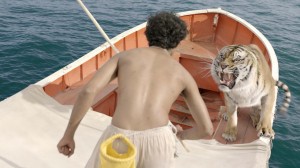
Based at Rhythm & Hues, VFX supervisor Bill Westenhofer has overseen teams of artists working with animals for features films, particularly animals that talk. These films include Golden Compass, the Stuart Little films, the second Men in Black and The Chronicles of Narnia: The Lion, the Witch, and the Wardrobe, among others.
Director Ang Lee’s adaptation of the best-selling Life of Pi was a different animal altogether. Lee said to the R&H crew, “I want to make art with you,” and Westenhofer was charged with creating a menagerie of storm-tossed zoo animals; specifically the tiger who shares a life raft with the titular character, Pi. And while writer Yann Martel’s bestselling novel may carry its own type of mysticism in its pages, it’s not a Narnia or Golden Compass installment: This tiger crouches, hides, roars and kills exactly like a real one, because it is real.
At least it was real in a small percentage of the shots. But for most of the film, the very real tiger was digital, the success of which Westenhofer attributes to advances like the improved lighting for fur and improvements in subsurface scattering, which allows below-the-skin muscle movement and luminosity, which figures prominently in FX award season handicapping this year, with other “realized beings” like The Hobbit’s Gollum.
“It’s so easy to anthropomorphize things,” he said. But in the case of Pi, they started with a real tiger, from French trainer Thierry LePortier. Out of all the tigers LePortier had available, Lee picked one called King to be the basis of his four-legged lead. He was “the most ‘star-looking’ tiger,” Westenhofer conceded.
 But with a year of previs – which would be followed by a year of post – Westenhofer’s crew had already begun building their tiger before King was picked out. “We had to make to adjustments to the build we’d made,” he said.
But with a year of previs – which would be followed by a year of post – Westenhofer’s crew had already begun building their tiger before King was picked out. “We had to make to adjustments to the build we’d made,” he said.
Making continued refinements was all part of the process, especially with the realization that tigers – for all their jungle gravitas – are, as Westenhofer puts it, “loose bags of skin over tight muscles.”
His group was able to observe King’s muscles in action and watch him in a blue-screened pen. They eventually introduced a lifeboat to the pen, and then a camera, to catalog King’s movements. But it wasn’t just a matter of getting the tiger right. This was a story of a man and tiger, lost at sea.
So naturally, there was water – lots of water. “Whenever you use water, things change,” Westenhofer said. “Stereo complicates post,” he emphasized, regarding the 3D aspect of the film. But he thought it helped reinforce that boy and tiger were in the middle of nowhere. Westenhofer credited The Moving Picture Company with the responsibility for the sinking of the ship from which the life raft in the story comes and the storm sequence.
“They found a great way of shaping the seas,” he said, recounting the challenge of matching digital water with the real thing, in both R&H’s sequences, and MPC’s. The matching worked, as it did with the tiger. They had taken some of the live footage of LePortier’s King, and made a “digital swap.” As it turned out, Lee couldn’t see the difference. “You could tell he was pleased,” Westenhofer said.





